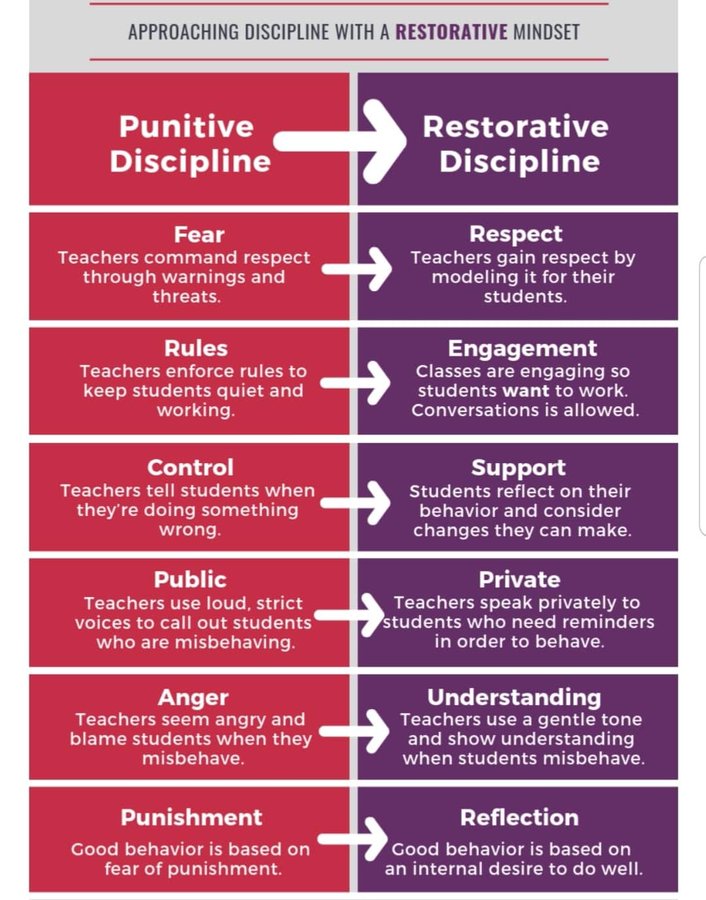
The always-entertaining Twitter account of James Lindsay recently posted a placard via Brad Weinstein of the organization Teacher Goals which compares so-called “punitive” school discipline to its “restorative” counterpart.
As a teacher who taught for over a quarter century, I became fairly adept at sifting through the BS regarding curricular and class management needs.
One thing which always raised my BS hackles was the “consultants” who were chock full of the latest edu-fads and pawned them off as the greatest things since the internet.
Restorative discipline (see also: “restorative justice,” “restorative practices”) is one such edu-fad. Its basic tenet holds that teachers should not scold and/or actually punish students for misbehavior, but discover what’s behind their acting out … and then work on a remedy for it. In non-punitive way.
Upon examining the chart below you may think “of course, any good teacher would incorporate aspects of both columns.” It is totally naive, however, to believe that using only a restorative approach is what’s best for all students.
But this is what we see in more and more schools across the country.
The chart’s first row is a perfect example. A good teacher naturally will model respectful behavior, but warnings and threats are necessary from time to time, especially for the chronically misbehaved. Say you have a class of 33 kids and one of them is constantly talking/yelling during a lesson, in addition to physically poking other students around him. After several “respectful” and “polite” reminders to this student about appropriate conduct, what do you do next?
MORE: White students who make racist puns are exempt from ‘restorative justice’
A) Threaten to send the student out of class, or
B) Continue with a “gentle tone” and ask the perpetually misbehaving student to “reflect” on what he’s doing wrong.
If you care about the other 32 kids in the class, choice “A” is the obvious response.
A teacher who constantly attempts to appeal to a chronically misbehaving 12-year-old student’s “better nature” is demonstrating an exercise in futility — because the student likely doesn’t have one. And this futility penalizes the entire classroom. This mindset can be seen on a macro scale in big cities such as San Francisco, Los Angeles, Seattle and Philadelphia where attorneys general and others in the government and law enforcement use a “gentle tone” and show “understanding” with the criminal element.
The result is rampant crime and a low quality of life for everyone.
 As I noted last year, renowned author Robert Heinlein warned us decades ago about this approach. “Do-gooders attempted to ‘appeal to [such students’] better natures,’ to ‘reach them,’ to ‘spark their moral sense,’” Heinlein wrote. But these kids “had no ‘better natures’; experience taught them that what they were doing was the way to survive.
As I noted last year, renowned author Robert Heinlein warned us decades ago about this approach. “Do-gooders attempted to ‘appeal to [such students’] better natures,’ to ‘reach them,’ to ‘spark their moral sense,’” Heinlein wrote. But these kids “had no ‘better natures’; experience taught them that what they were doing was the way to survive.
“The puppy never got his spanking; therefore what he did with pleasure and success must be ‘moral.’”
The good news is that I witnessed teacher trainings on restorative discipline serve to unite those on opposite sides of the political spectrum … in being opposed to such trainings. Even hardcore politically progressive educators want the option of removing chronically disruptive students from their classrooms if the need arises. Nothing turns them (and teachers of all political stripes) off more than a Brad Weinstein-type administrator (left) who denies them that very option.
Indeed, one of the first respondents to Lindsay’s tweet about the (Weinstein) chart wrote “I’ve seen [restorative discipline] firsthand and it does NOT work. Kids learn to take advantage of it real quick. It was the norm at my last job and I got out as fast as I got in. Last principal at my current job did it during the pandemic and teacher morale dropped … new principal came this school year with a red column no-nonsense attitude and issues have dropped big time.
What’s needed is more these folks speaking out against administrative edicts at the school and central office level on restorative discipline … and a school board which backs them up.
MORE: Study on school suspensions highlights educationists’ misplaced priorities
IMAGES: PhotographeeDOTeu/Shutterstock.com; Twitter screencaps







Please join the conversation about our stories on Facebook, Twitter, Instagram, Reddit, MeWe, Rumble, Gab, Minds and Gettr.